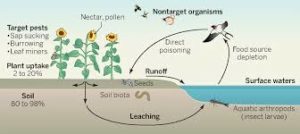16
Jan
Take Action: Tell EPA that Neonics Pose Unacceptable Ecological Threats!
(Beyond Pesticides, January 16, 2018) In spite of findings that neonicotinoid (neonic)  insecticides pose both acute and chronic risks to pollinators, aquatic life, and birds, the U.S. Environmental Protection Agency (EPA) is seeking comment that could support their continued use. Comments are due by February 20, 2018.
insecticides pose both acute and chronic risks to pollinators, aquatic life, and birds, the U.S. Environmental Protection Agency (EPA) is seeking comment that could support their continued use. Comments are due by February 20, 2018.
Tell EPA that neonics pose unacceptable risks to pollinators, aquatic life, and birds! And, ask your Congressional delegation push EPA to do the right thing.
Last month, EPA released preliminary ecological (non-pollinator) assessments for the neonicotinoids clothianidin, thiamethoxam, dinotefuran, and the terrestrial ecological assessment for imidacloprid, finding that these pesticides pose both acute and chronic risks to aquatic life and birds. Treated seeds are identified as posing the highest dietary risks to birds, confirming previous research that neonics are highly hazardous not only to bees, but also, to birds, aquatic life, and other non-target organisms. However, EPA’s assessments also cover spray treatments.
EPA opened the public comment period for these assessments on December 15, 2017. Along with outlining the risks identified in the assessments, the agency is especially requesting feedback on the benefits of continued use of the neonics on cotton and citrus crops, identified in last year’s pollinator assessments as posing risks to honey bees. In spite of evidence of long-term systemic exposures to non-target organisms, which supports a phase-out of these pesticides, EPA states, “We believe early input from the public will be helpful in developing possible mitigation options that may be needed to address risks to bees.” EPA believes that neonicotinoids are crucial for the management of the Asian citrus psyllid, an invasive pest that causes citrus greening, and of plant bugs and stink bugs in cotton. However, non-chemical, or biological, management methods have been successfully employed.
Tell EPA that neonics pose unacceptable risks to pollinators, aquatic life, and birds! Tell your Congressional delegation to push EPA to do the right thing.
EPA found that risks to certain birds from eating neonic-treated seeds exceed the agency’s level of concern by as much as 200-fold. For clothianidin, the agency finds that as few as 1–5 seeds of treated corn will be enough to exceed acute and chronic levels of concern for birds. Specifically, EPA states, “Dietary exposures from clothianidin treated seeds are noted to result in the highest acute and chronic risks from the terrestrial risk assessment to birds and mammals.” Clothianidin, which is widely used as a seed coating on millions of acres of planted corn and soybean crops, is also determined by EPA to be very highly toxic to other taxa, including shrimp and aquatic insects. Reproductive effects are observed in several freshwater and estuarine/marine invertebrates. Developmental effects have occurred in benthic invertebrates (those living at the bottom of water bodies).
EPA has already released the preliminary pollinator assessment for the neonics, which identifies risks to pollinators from a variety of uses on agricultural crops. The aquatic assessment for imidacloprid, also released last year, finds that it threatens the health of U.S. waterways with significant risks to aquatic insects and cascading effects on aquatic food webs.
Other neonics are also problematic. For example, for thiamethoxam, EPA finds, “Chronic risk concerns for aquatic insects result from exceedances of effect levels on larval survival. Effect levels are also exceeded frequently (in 10–29 years over a 30-year period) for foliar treatments, suggesting yearly variations (e.g., in weather) do not change risk potential.” And for dinotefuran, “A number of uses of dinotefuran have the potential for direct adverse effects to aquatic invertebrates on an acute and chronic basis based on an evaluation of multiple lines of evidence.”
As a result of risks to pollinators and aquatic organisms, regulators in Canada, the UK, and Europe have adopted or are considering bans on neonics. Research has consistently linked their use to reduced learning in bees, and as a contributing factor to reduced colony size, and reproductive success. U.S. beekeepers lost an unsustainable 33% of their hives between 2016 and 2017.
Studies on songbirds find that exposure to widely used insecticides such as neonicotinoids results in failure to orient properly for migration, thus adding weight to arguments that pesticides are a likely cause in the decline of migratory bird populations.
Neonics are also detected regularly in the nation’s waterways at concentrations that exceed acute and chronic toxicity values for sensitive organisms. The Beyond Pesticides report Poisoned Waterways documents the persistence of neonicotinoids in U.S. waterbodies and the danger they cause to aquatic organisms, resulting in complex cascading impacts on the aquatic food web. The report also highlights current regulatory failures of EPA aquatic standards, which continue to underestimate risks to sensitive species, due to a reliance on test protocols that do not reflect real-world exposures or susceptibilities.
All unattributed positions and opinions in this piece are those of Beyond Pesticides.










